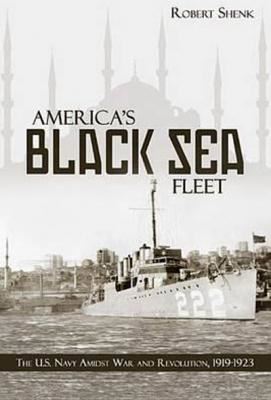America’s Black Sea Fleet: The U.S. Navy Amidst War and Revolution, 1919-1921
Robert Shenk
 America’s Black Sea Fleet: The U.S. Navy Amidst War and Revolution, 1919- 1923, by Robert Shenk, offers a rare glimpse of the American naval presence in post- World War I Europe and Western Asia. His holistic representation of the events surrounding the fleet’s activities, from relief work to back-door diplomacy, allows readers to immerse themselves fully in this often-overlooked segment of world history. In particular, Shenk succeeds in his goal of presenting an overarching, non-biased view of American-Turkish relations during this time, particularly concerning the Armenian genocides. In such a heated debate, it is a breath of fresh air to see Admiral Bristol represented, not as a singular ideal, but as a man, capable of good deeds even with his shortcomings.
America’s Black Sea Fleet: The U.S. Navy Amidst War and Revolution, 1919- 1923, by Robert Shenk, offers a rare glimpse of the American naval presence in post- World War I Europe and Western Asia. His holistic representation of the events surrounding the fleet’s activities, from relief work to back-door diplomacy, allows readers to immerse themselves fully in this often-overlooked segment of world history. In particular, Shenk succeeds in his goal of presenting an overarching, non-biased view of American-Turkish relations during this time, particularly concerning the Armenian genocides. In such a heated debate, it is a breath of fresh air to see Admiral Bristol represented, not as a singular ideal, but as a man, capable of good deeds even with his shortcomings.
Shenk has certainly proven himself as an historical researcher. In writing this book, he utilized a variety of public and private source material in his attempt to present a well-rounded interpretation, including diaries, ship logs, correspondence, archival collections, photographs, and more. This enterprising appetite for published and unpublished source material is impressive. In particular, his extensive use of the Mark L. Bristol papers for the good of the overall scholarly argument, rather than as propaganda for a one-sided attack, is certainly commendable. His endnotes allow ease for both the casual reader and the serious historian, as the background information and sources are present, but do not interfere with the general flow of the work.
Shenk’s organizational scheme, on the other hand, leaves something to be desired. Though most social histories are thematic, this one tends to jump across years, continents, and ships, with little to no respect for the reader. Additionally, Shenk discusses individual naval movements without giving them an appropriate context in the history of the area, though he states this as one of his goals in the preface. This is true for the end of World War I as well as the immediate after-effects in Greece, Turkey, the Balkans, and particularly post-revolutionary Russia. A more detailed account of the situation, as well as maps to orient the reader, would have been extremely helpful. Both casual readers and naval historians alike might suffer from the lack of historical context. Additionally, the writing was awkward and disjointed in many places. Decisions in word choice, phrasing, and punctuation, should have worked for the storyline, rather than against it. The overuse of parenthetic remarks was particularly frustrating. If the purpose of the endnotes was to allow for readability, Shenk could have also avoided the prolific use of parentheses, most of which he could have worked into the text or relegated to the notes section.
This book is certainly more than a naval history. While it examines naval officers, operations, and vessels, it also gives a brief insight into the society of post-World War I Eastern Europe and Western Asia. Shenk focuses on individual ships, but also on the basic human condition during this tumultuous era. This work perhaps would have benefitted from more time in the editing process. It stands, however, as a good example of primary source research and is an excellent addition to the subject literature.
- Annapolis: Naval Institute Press, 2012
- 6-1/4” x 9-1/4”, hardcover, xviii + 366 pages
- Photographs, maps, notes, bibliography, index. $34.95
- ISBN: 9781612510538
Reviewed by Chelsea Freeland, East Carolina University
